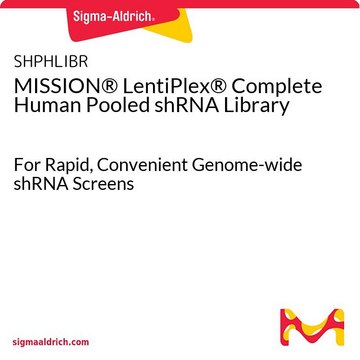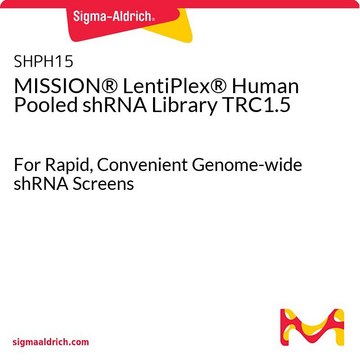推荐产品
產品線
MISSION®
濃度
≥5x108 VP/ml (via p24 assay)
技術
capture ELISA: 5 × 108 TU/mL using p24
運輸包裝
dry ice
儲存溫度
−70°C
一般說明
MISSION LentiPlex Pooled Libraries bring the power of the MISSION TRC shRNA collection together with Sigma′s lentiviral manufacturing expertise to enable genome-wide RNAi screens at your bench-top. The LentiPlex pooled system provides enhanced delivery and long-term gene silencing in non-dividing and primary cell lines allowing unlimited discovery potential. The convenient format now makes rapid whole-genome RNAi screens accessible to any researcher with minimal reagent, time or capital equipment investment.
The MISSION LentiPlex Mouse shRNA Pooled Library is a genome-wide lentiviral pool produced using a proprietary process. The library consists of over 75,000 shRNA constructs from the TRC collection targeting 15,000+ mouse genes. Each library is tested for shRNA representation before product release to ensure robust library coverage. The library is provided in ready-to-use lentiviral format at titers of at least 5 x 108 TU/ml via p24 assay and is pre-divided into ten subpools of approximately 8,000 shRNA constructs each. Amplification and sequencing primers are also provided for downstream target identification.
The library is pre-divided into ten subpools of approximately 8,000 shRNA constructs each. Each library is enough material for six screens at 100X representation.
Please visit sigma.com/lentiplex to learn more and see example data and uses.
The MISSION LentiPlex Mouse shRNA Pooled Library is a genome-wide lentiviral pool produced using a proprietary process. The library consists of over 75,000 shRNA constructs from the TRC collection targeting 15,000+ mouse genes. Each library is tested for shRNA representation before product release to ensure robust library coverage. The library is provided in ready-to-use lentiviral format at titers of at least 5 x 108 TU/ml via p24 assay and is pre-divided into ten subpools of approximately 8,000 shRNA constructs each. Amplification and sequencing primers are also provided for downstream target identification.
The library is pre-divided into ten subpools of approximately 8,000 shRNA constructs each. Each library is enough material for six screens at 100X representation.
Please visit sigma.com/lentiplex to learn more and see example data and uses.
其他說明
Deconvolution of shRNA Pools
Sigma′s deconvolution service lets you easily identify the genes that impact your pooled shRNA screen.
MISSION custom pooled viral shRNA libraries
Pooled shRNA RNAi screening approaches are fast becoming an economical alternative for cell based screens. MISSION RNAi is now offering custom pooled shRNA viral libraries. Just give us your list of genes or pick a gene set and leave the rest to us!
Contact your local Sigma sales representative for more information or submit an inquiry to MISSION RNAi
Sigma′s deconvolution service lets you easily identify the genes that impact your pooled shRNA screen.
- Next-generation sequencing of clonesgives a precise number of individual clone occurrence within a pooled shRNA sample
- Comprehensive, reproducible results from pooled shRNA screens
- Statistically robust and information-rich data
MISSION custom pooled viral shRNA libraries
Pooled shRNA RNAi screening approaches are fast becoming an economical alternative for cell based screens. MISSION RNAi is now offering custom pooled shRNA viral libraries. Just give us your list of genes or pick a gene set and leave the rest to us!
Contact your local Sigma sales representative for more information or submit an inquiry to MISSION RNAi
法律資訊
LentiPlex is a registered trademark of Merck KGaA, Darmstadt, Germany
MISSION is a registered trademark of Merck KGaA, Darmstadt, Germany
儲存類別代碼
12 - Non Combustible Liquids
水污染物質分類(WGK)
WGK 3
閃點(°F)
Not applicable
閃點(°C)
Not applicable
Wei Li et al.
Journal of molecular biology, 430(17), 2734-2746 (2018-05-26)
Xist (inactivated X chromosome specific transcript) is a prototype long noncoding RNA in charge of epigenetic silencing of one X chromosome in each female cell in mammals. In a genetic screen, we identify Mageb3 and its homologs Mageb1 and Mageb2
Ting Zhao et al.
Cell stem cell, 23(1), 31-45 (2018-06-26)
Chemical reprogramming provides a powerful platform for exploring the molecular dynamics that lead to pluripotency. Although previous studies have uncovered an intermediate extraembryonic endoderm (XEN)-like state during this process, the molecular underpinnings of pluripotency acquisition remain largely undefined. Here, we
Christine Karlsson et al.
Methods in molecular biology (Clifton, N.J.), 650, 29-43 (2010-08-06)
Identifying the genes and pathways that regulate self-renewal and differentiation in somatic stem cells is a central goal in stem cell and cancer biology. Here, we describe a method for RNAi-based screens in primary human hematopoietic stem and progenitor cells.
Functional dissection of lysine deacetylases reveals that HDAC1 and p300 regulate AMPK.
Lin, Yu-yi, et al.
Nature (2012)
Richard Possemato et al.
Nature, 476(7360), 346-350 (2011-07-16)
Cancer cells adapt their metabolic processes to drive macromolecular biosynthesis for rapid cell growth and proliferation. RNA interference (RNAi)-based loss-of-function screening has proven powerful for the identification of new and interesting cancer targets, and recent studies have used this technology
商品
Presenting an article on Pooled Lentiviral shRNA Screens to Identify Essential Cancer Pathways
我们的科学家团队拥有各种研究领域经验,包括生命科学、材料科学、化学合成、色谱、分析及许多其他领域.
联系技术服务部门








